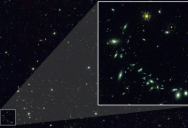Astronomers Have Counted Over 800 Stars That Have Disappeared Without A Trace. Now They Think They Know What Happened.

When looking up into the night sky, you can see millions of stars with the naked eye. When using high-powered telescopes, that number jumps up into the billions.
While most people cannot point out too many specific stars, they know they are always there. Throughout human history, people have even used the consistency of the stars to aid in navigation, planning, and much more.
Of course, today we know that stars do eventually die, often in brilliant explosions known as supernovae. Smaller stars can also simply fade out over time as they exhaust their fuel sources.
Over the past 70 years, however, scientists have documented another phenomenon with stars. They simply disappear without a trace. Astronomers look at the star at one point, then when they return (even just an hour later), and it is gone.
What makes this even more unusual is that the star never returns.

There have been over 800 cases of this documented so far, and they have largely left astronomers baffled.
New research from astronomers at the University of Copenhagen, however, has published a paper that may offer an explanation.
The study’s co-author, Alejandro Vigna-Gomez said in a statement:
“Were one to stand gazing up at a visible star going through a total collapse, it might, just at the right time, be like watching a star suddenly extinguish and disappear from the heavens. The collapse is so complete that no explosion occurs, nothing escapes and one wouldn’t see any bright supernova in the night sky.”
This can happen, they theorize, when massive stars collapse under their own gravity and become black holes, or extremely dense neutron star, immediately.
All detectable evidence that this occurred would be captured by the gravity and sucked back in, leaving nothing for us to see. From our perspective, it would look like the star simply disappeared.

The evidence that they used is from observing a binary star system that is called VFTS 243. In it, a star that is about ten times more massive than our sun is orbiting with a black hole. Vigna-Gomes says of this situation:
“The orbit of the system has barely changed since the collapse of the star into a black hole.”
One obvious problem with this type of theory is that it is difficult to gather any type of hard evidence for it.
All the energy, partials, and even light would be sucked back down into the black hole. in this type of case, scientists can theorize what would happen and compare it to the data that is available.
So far, it seems that things fit well.
Of course, more research is needed before the theory can be widely adopted.
Who knew that stars could disappear?
If you thought that was interesting, you might like to read about a second giant hole has opened up on the sun’s surface. Here’s what it means.

Sign up to get our BEST stories of the week straight to your inbox.




